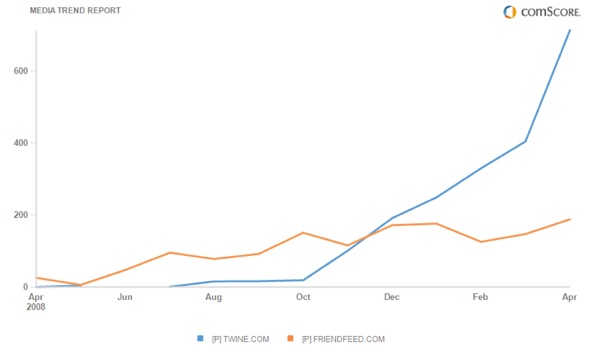
It turns out that people are following more than just their friends online. Look at the comScore chart above comparing unique visitors in the U.S. to FriendFeed versus Twine. Yeah, I was shocked to see that Twine has more than three times as many unique monthly visitors as FriendFeed (714,000 vs. 188,000). On a worldwide basis, comScore shows FriendFeed still slightly ahead of Twine. ComScore doesn’t always do a great job with small sites, so I checked Compete, which shows Twine with 2.25 million monthly visitors in April versus 998,000 for FriendFeed (see embed below). Different numbers, same story.
While FriendFeed is organized around following feeds of your friends’ activities across the Web, Twine is organized around interest feeds. Essentially, Twine members create topic pages that others can follow. It requires more work than FriendFeed. You have to add items such as links,articles, videos, and notes. But once you do, Twine organizes them for you using an underlying semantic index and tagging technology combined with social inputs from the community. So in a sense it competes more with Mahalo or Squidoo in that it creates authoritative pages around topics, except that these pages are really constantly updated topic or interest feeds that anyone can add to. You can read more about the original concept here, which relaunched publicly in October, 2008. All the growth is from October.
I pinged Nova Spivack, CEO of Radar Networks, the company behind Twine, to ask what’s up. He says that both the Compete and comScore numbers are off, but the trend is right. The initial growth came simply from letting people in who had been on the waiting list. But even he is surprised by the growth rate. So far five million items have been bookmarked in Twine. There are now 200,000 registered users who have created Twines (its name for interest feeds) across 30,000 different interest groups. The rest of the traffic comes from people visiting those topic pages.
And it is not all SEO traffic. Spivack provides the following breakdown of traffic by source: 59 percent comes from people coming directly to Twine, 20 percent comes from search engines, and most of the rest comes from people who receive email notifications and daily digests tracking the interest feeds they’ve signed up for. About 2 percent of traffic comes from twitter, but that portion is “rising fast.”
Following interesting people is just a proxy for following your interests, and Twine lets you connect with like-minded people as well. It is the combination that is killer.
